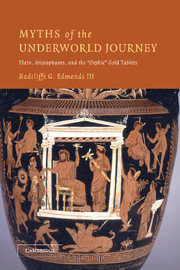Book contents
- Frontmatter
- Contents
- Preface
- 1 Introduction: The Start of the Journey
- 2 Roadmaps of Déviance: The ‘Orphic’ Gold Tablets
- 3 Descent to the Depths of Comedy: The Frogs of Aristophanes
- 4 The Upward Path of Philosophy: The Myth in Plato's Phaedo
- 5 Conclusions: The End of the Road
- Bibliography
- Index Locorum
- Index
5 - Conclusions: The End of the Road
Published online by Cambridge University Press: 13 October 2009
- Frontmatter
- Contents
- Preface
- 1 Introduction: The Start of the Journey
- 2 Roadmaps of Déviance: The ‘Orphic’ Gold Tablets
- 3 Descent to the Depths of Comedy: The Frogs of Aristophanes
- 4 The Upward Path of Philosophy: The Myth in Plato's Phaedo
- 5 Conclusions: The End of the Road
- Bibliography
- Index Locorum
- Index
Summary
Having reached the end of the road, it is perhaps worthwhile to look back at the route we have taken. The starting point is a group of texts: the Orphic gold tablets, Aristophanes' Frogs, and the myth in Plato's Phaedo, all of which share a common pattern of action: the journey to the underworld. To analyze these texts more neatly, I divided the narratives into complexes of obstacle, solution, and result. Despite the similarity of the obstacles for the traveler described in these myths of the journey to the underworld, the limited types of solutions employed to bypass these obstacles, and the same basic descriptions of the possible positive and negative results, these elements all have profoundly different significance within the individual narratives.
This variation, I argue, calls into question the attribution of any single meaning to the story of the journey to the underworld as well as any simple explanation of the myths as the products of Orphic doctrines about the afterlife. The definitions of ‘Orphism’ as a sect with an exclusive set of eschatological ideas, definitions rooted in Christian models of what a religion ought to be, must be replaced by a definition that takes into account the ways in which the ‘Orphic’ sources make use of the common stock of traditional material. Redefining Orphism in such a way permits a better understanding of the variety of eschatological ideas in Greek religion, including the much-debated relation of the Eleusinian Mysteries to the various countercultural Bacchic and Orphic movements.
- Type
- Chapter
- Information
- Myths of the Underworld JourneyPlato, Aristophanes, and the 'Orphic' Gold Tablets, pp. 221 - 240Publisher: Cambridge University PressPrint publication year: 2004



